AMD Radeon HD 6850 Overclocking Roundup: Asus, XFX, & MSI
by Ryan Smith on November 8, 2010 12:40 AM ESTOverclocking: Performance, Power, Temperature, & Noise
Half of our results focus on our 6850s at their stock clocks, but the other half of our results focus on the card when it comes to overclocking. As a lower clocked Barts card, 6850 cards not binned for poor maximum clocks should have a fair bit of overclocking room as AMD intended for the design to hit 900MHz+. The 6850’s power efficiency pretty much has to go out the window here, but in return we can capture some significant performance gains.
| Overclocking Results | ||||||
| Stock Clock | Max Overclock | Stock Voltage | Max Overclocked Voltage | |||
| Radeon HD 6850 Reference | 775MHz | 940MHz | 1.094v | 1.172v | ||
| XFX Radeon HD 6850 | 775MHz | 940MHz | 1.148v | 1.172v | ||
| MSI R6850 OC | 820MHz | 960MHz | 1.148v | 1.22v | ||
| Asus EAH6850 | 790MHz | 960MHz | 1.148v | 1.22v | ||
When overclocking, we found 3 things:
- All of the cards could hit 850MHz core at stock voltage
- All of the cards could hit 940MHz core at 1.172v, the 6870 load voltage
- We had to give the cards significantly more voltage to get above 940MHz. This culminated at 1.22v on the Asus and MSI cards for 960MHz
Based on these results we went ahead and benchmarked the Asus card at 850/1150, 940/1150, and 960/1150 to showcase the performance at these overclocks, while capturing data for all of the cards at 1.172v, and the Asus and MSI cards at 1.22v.
While it’s possible to hit 960MHz with enough voltage, in practice it’s not worth the effort. The Asus and MSI cards jumped in power consumption, temperature, and noise by around 20W, 3C, and 2dB each, for a performance difference of under 2%. On a higher-end card where performance is the only attribute that matters this wouldn’t really matter, but we would not consider this a useful tradeoff on a petite card like the 6850.
As for memory overclocking, we hit at solid wall at 1150MHz as none of our cards could do 1200MHz without artifacting. However 1150MHz didn’t trigger performance degradation due to error correction-induced retransmission, so it looks to be a safe frequency for all cards. The limit we believe lies solely with the memory controller, which was a conscientious decision by AMD to trade memory clocks for a smaller die. As a result the controller reaches its limit before we can even push the 5GHz GDDR5 to spec.
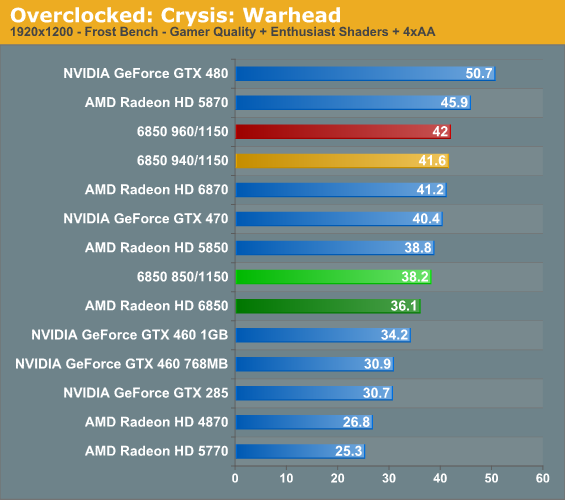
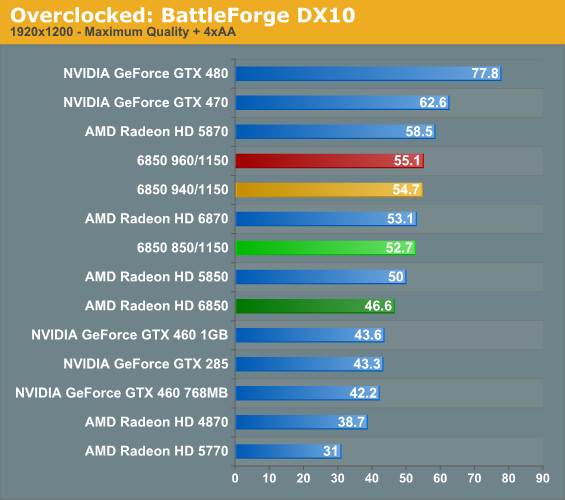


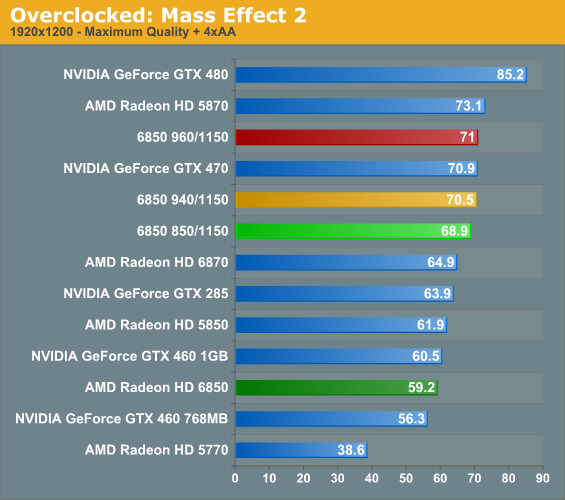
Something that caught us completely off-guard in our results is just how well the overclocked 6850 did. Even at the “mere” speed of 850/1150, it’s faster than the 6870 in 3 out of our 5 games; and the 6870 still has a core clockspeed advantage and more SIMDs! The advantage for our overclocked 6850s is that the memory clock of 1150MHz (4.6GHz effective) is faster than the 6870’s memory clock of 1050Mhz (4.2GHz effective), and this looks to be the reason for the difference. Based on all the data we have, Barts looks to be memory bandwidth starved in around half the games we use. From this it looks like a good memory overclock is going to go a long way on the 6850 and 6870 towards improving performance.
As for how much of an overclock is necessary, this depends on the game. When Barts is memory bandwidth starved, the 940Mhz and 960Mhz memory overclocks provide only a small boost; while on shader-bound games like Crysis there’s a very tangible benefit. Combine the memory overclock with a 940Mhz core overclock and the 6850 can meet or beat the 6870 every single time. The voltage increase necessary to achieve this core overclock comes at a price however.

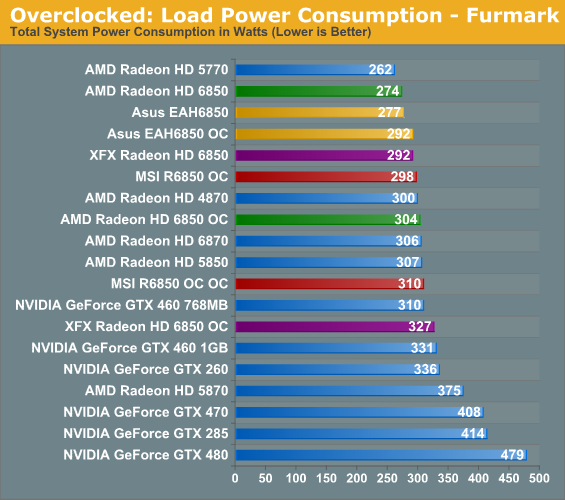
Starting with power consumption, the voltage increase necessary for 940MHz is around 20W-30W under FurMark for our reference and near-reference clocked cards, and less for the MSI card since it already has a notable factory overclock. If nothing else, 1.172v gives up all the power advantages over the Radeon 5850, though as we’ve seen it pays off with a very notable performance advantage over the 5850.
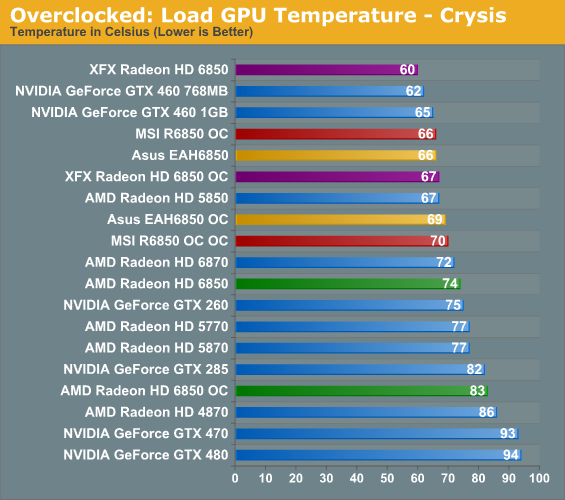

For the partner cards in today’s roundup, the temperature runup from overvolting isn’t too bad, with the worst card only hitting 81C under FurMark and becoming progressively cooler from there. However the reference 6850 is an entirely different story: it hits 93C under FurMark, which is hotter than what we’re comfortable with for Barts, particularly since it’s brand new. If reference-style cards show up on the market, we would not recommend overvolting them, at least not to 1.172v. Meanwhile the XFX card with its focus on temperature tops this chart, still only hitting 74C under FurMark. The cooling on this card is so good that we suspect the VRMs will burn up long before the GPU will when overvolting.
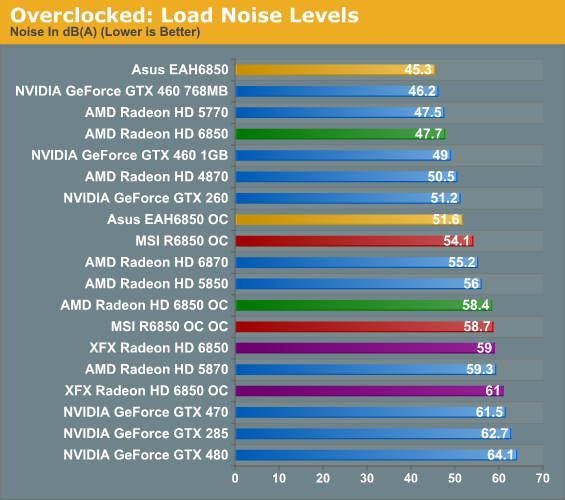
Finally we come to noise. We suspect many buyers will be alright with the power and temperature increases so long as noise remains manageable, so what we have is a mixed bag. Throwing out the reference 6850, we’re left with the XFX card at over 60dB, and while XFX’s focus on temperatures is commendable, it ends up being shortsighted by making the card exceptionally loud here. This is followed by the double-overclocked MSI card, which at 58.7dB is over 3dB louder than the 6870, but is only encroaching on the 5870. It’s too much noise for the performance, but compared to first-gen 40nm cards it’s not the end of the world.
This leaves us with the Asus card. While it does jump by 6dB due to our overclocking, it had such a massive lead at stock that this only makes it about as loud as the GTX 260 and Radeon HD 4870. The idea of a near-silent card has gone out the window at this point, but we would consider it a very manageable level of noise for the performance offed with the 940/1150 overclock. Certainly it’s the most balanced of the cards, as it sacrifices only little in the way of cooling (78C in FurMark) for the lower level of noise generated.










93 Comments
View All Comments
Will Robinson - Monday, November 8, 2010 - link
Yep, the stuff said so far about AT being smart to discuss this is right.I don't think anyone seriously believes the site would be biased.
I trust AT.
Having said that it's a shame those people who dismiss the complaints of many over the inclusion of overclocked cards don't wise up a bit.
They don't agree with you but it doesn't mean they are wrong.
expose - Monday, November 8, 2010 - link
What the title says, might as well admit within the article that you are catering to a audience and no longer practicing journalism. http://en.wikipedia.org/wiki/JournalismDoing a o/c feature on a card and then print a conclusion based on no results from the competitors stock o/c or any o/c results this time is amateur.
No longer professional or unbiased, and almost useless content because of random unpredictable motives.
jabber - Monday, November 8, 2010 - link
I was rather dissapointed two weeks ago when we had all the 6850/6870 reviews that put stock AMD units up against purely OCd Nvidia units and no one seemed to dare to just OC a 6850/70 to a similar degree for the sake of apples to apples. I guess Nvidia's review instructions to the tame (paid) press worked a charm.Ok so putting OCd AMD units against non OCd Nvidia units may redress the balance but its still not what any of us wanted to see in the first place.
Am I the only one not taking crazy pills around here?
We's like to see a list of stock AMD and Nvidia unit benchmarks and then a list of OCd AMD/Nvidia units.
Just like in the old days. Is that too hard?
FeynmanDIagrams - Monday, November 8, 2010 - link
Unfortunately reviewers can't always include 100 different comparisons due to time constraints. It takes a long time to benchmark a single card. This reviewer might not of had access to a 460FTW either.I use a standard MSI Cylone 460 1GB that I manually OC'd to 950/1050 on air. You don't have to buy the "super super overclocked" editions to get these speeds, just have adequate cooling. You're typically only going to find extreme overclock comparisons on overclocking forums rather than review sites.
While they don't include PhysX or CUDA, they are affordable mid-range cards that help keep competitor's prices in check. While AMD has had Crossfire driver issues in the past, Nvidia still seems to have major stuttering issues and low GPU usage for the past 9 months. They also seem to require you to run on a Bloomfield chip to have decent GPU usage(even that doesn't always fix it), where as even the 5870/5970 can make full use of the card on a modest Phenom or C2Q chip.
The 6850/6870 seem like excellent choices compared to their 460/470 competitors.
softdrinkviking - Monday, November 8, 2010 - link
you wrote... All of the cards could hit 850MHz core at stock clocksAll of the cards could hit 940MHz core at 1.172v, the 6870 load voltage
We had to give the cards significantly more voltage to get above 940MHz. This culminated at 1.22v on the Asus and MSI cards for 960MHz
I think "All of the cards could hit 850MHz core at stock clocks," should be "All of the cards could hit 850MHz at stock VOLTAGES," but maybe I am completely misunderstanding the info reported here?
jcn4boxes - Monday, November 8, 2010 - link
mm2587, while obviously upset, has a valid point.amd vs nvidia "fan boyz" should have no place in hardware reviews, imo.
rather the data should be presented and let that speak for itself.
i hope the "kicking to the curb" notion is just that and not a peace offering to a advertiser/contact.
Galcobar - Monday, November 8, 2010 - link
Never understood the flaming which results when a review includes factory overclocked video cards.For one point, it's not a YMMV situation -- a card purchased with a factory overclock will conform to those specifications. Think of it this way: if all the stock clocked cards were pulled from the market, would that mean the cards are no longer reviewable? Of course not, given the stock clocks are as much an arbitrary factory choice (to achieve a certain yield) as the overclocks.
Where it gets particularly odd is how processors whose only difference is the multiplier can be reviewed with no howls of indignation. When Intel turns up the multiplier and sticks a higher model number on it, they're issuing a factory overclocked chip and charging more for it. Yet no one complains a 950 should not be reviewed next to a 930...
The whole point of reviews is to look at price, performance, and the balance between.
khimera2000 - Monday, November 8, 2010 - link
ill give you a clue. one is overclocked, and represents the top of the OC scale for factory cards, also represents what a hand picked model can do.the other is a stock card.
at the time it was the only card i found that clocked at that speed, and the others trailed by at least 100mhz. the FTW card is just nvidia showing off and did not represent what was available on average at the time.
Just like now where its noted that its vary difficult to find non OC 6850, but these where not included in the review even though they where available the day i read the review.
it would mean that AT would have hand pick a card for every new releas. I can see that being a pain.
totenkopf - Monday, November 8, 2010 - link
Galcobar, your comparison to processors is a little misleading. when Intel augments the speed of their silicon, the respective parts are sold with distinct model numbers (950 vs. 930 as you pointed out) which is far different, and more dependable, than the 'OC' nomenclature. OCed graphics cards, on the other-hand, share the same technical designation with their non OCed counterparts. If little Billy asks his mom for a GTX460 FTW for Christmas, what do you suppose the odds are that he ends up with a stock GTX460 or some other 'OC' labeled variant?I will say that this whole argument is the stuff of fanboys. Purists and enthusiasts that frequent this site shouldn't be concerned with factory OC junk anyway, it all boils down to arguing over how one's favorite company is being represented. The whole OC edition thing is just money grab, product differentiation crap designed by OEMs to make people think they are getting a better product and part with more money. Usually the performance gain is negligible. Regardless, what good is an OCed card when they cost more money? The only consumer interest in OCing ought to be paying less to get more; which means you're better off getting the reference board for less money and making it faster. I don't think OCed cards have a place in reviews except in cases like this article. OCing was never supposed to be this mainstream, it defeats the whole purpose when it's up-cost marketing.
Besides, semantically speaking, if you buy it in that configuration, it's kinda still stock. The Shelby isn't an OCed Mustang... it's a Shelby. Tuning it yourself could be considered OCing.
Galcobar - Tuesday, November 9, 2010 - link
If you want to argue that the crucial difference lies in model numbers -- which is to say, labelling -- then you'd want to remember that cards with higher overclocks do use different model numbers.768-P3-1360-TR
768-P3-1362-TR
versus
i7-930
i7-950
That Intel sells the processors based directly on model number and uses the names in-house, while video cards are sold using the names and keeps the model numbers written small on the box doesn't really change the relationship.
Higher cost for what amounts to a software change.
Whether those software changes are worth paying for is another arguement entirely, but you are paying for an assured level of performance in either type of processor.